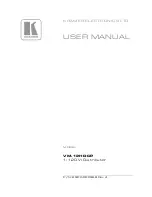
45
Subject to change without notice
C o m p o n e n t t e s t
With semiconductors the transition from the non-conducting
to the conducting state will be indicated in their characteristic.
As far as is possible with the available voltages and currents
the forward and backward characteristics are displayed
(e.g. with zener diodes up to 9 V). Because this is a two-pole
measurement, the gain of a transistor can not be determined,
however, the B-C, B-E, C-E diodes can be measured.
Please note that most bipolar transistors can only
take an E-B voltage of approx. 5 V and may be da-
maged if this is exceeded, sensitive HF transistors
take even much less!
With this exception the diodes can be measured without
fear of destruction as the maximum voltage is limited to
9 V and the current to a few mA. This implies, however, that a
measurement of breakdown voltages
>
9 V is not possible. In
general this is no dis-advantage because, if there is a defect in
a circuit, gross deviations are to be expected which will point
to the defective component.
Rather exact results may be achieved if the measurements
are compared to those of intact components. This is especially
true for semiconductors. The polarity of diodes or transistors
can thus be identified if the lettering or marking is missing.
Please note that with semiconductors changing the polarity
(e.g. by exchanging the COMP.TESTER and ground terminals)
will cause the display to rotate 180 degrees around the screen
center. More important in practice is the quick determination
of plain shorts and opens which are the most common causes
of requiring service.
It is highly recommended to observe the necessa-
ry precautions when handling MOS components
which can be destroyed by static charges and even
tribo electricity. The display may show hum if the
base or gate connection of a transistor is open,
i.e. it is not being tested. This can be verified by
moving a hand closeby.
11.2 In-circuit tests
They are possible in many cases but deliver rarely clear re
-
sults. By paralleling of real or complex impedances – espe
-
cially if those are fairly low impedance at 50 Hz/200 Hz – there
will be mostly great differences compared to individual com
-
ponents. If circuits of the same type have to be tested often
Fig. 11.1: Component tester at short
(service), comparisons with intact circuits may
help again.
This is also quickly done because the intact circuit has not to
be functional, also it should not be energized. Just probe the
various test points with the cables of the component tester of
the unit under test and the intact unit and compare the screen
displays. Sometimes the unit under test may already contain an
intact portion of the same type, this ist e.g. the case with stereo
circuits, push-pull circuits or symmetrical bridge circuits.
In cases of doubt one side of the dubious component can be
unsoldered, and this free contact should then be connected to
the COMP.TESTER contact which is not identified as the ground
contact. This will reduce hum pick-up. The contact with the
ground symbol is connected to the scope chassis and is thus
not susceptible to hum pick-up.
















































